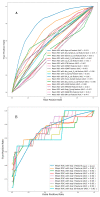Mortality Prediction Utilizing Blood Biomarkers to Predict the Severity of COVID-19 Using Machine Learning Technique
- PMID: 34573923
- PMCID: PMC8469072
- DOI: 10.3390/diagnostics11091582
Mortality Prediction Utilizing Blood Biomarkers to Predict the Severity of COVID-19 Using Machine Learning Technique
Abstract
Healthcare researchers have been working on mortality prediction for COVID-19 patients with differing levels of severity. A rapid and reliable clinical evaluation of disease intensity will assist in the allocation and prioritization of mortality mitigation resources. The novelty of the work proposed in this paper is an early prediction model of high mortality risk for both COVID-19 and non-COVID-19 patients, which provides state-of-the-art performance, in an external validation cohort from a different population. Retrospective research was performed on two separate hospital datasets from two different countries for model development and validation. In the first dataset, COVID-19 and non-COVID-19 patients were admitted to the emergency department in Boston (24 March 2020 to 30 April 2020), and in the second dataset, 375 COVID-19 patients were admitted to Tongji Hospital in China (10 January 2020 to 18 February 2020). The key parameters to predict the risk of mortality for COVID-19 and non-COVID-19 patients were identified and a nomogram-based scoring technique was developed using the top-ranked five parameters. Age, Lymphocyte count, D-dimer, CRP, and Creatinine (ALDCC), information acquired at hospital admission, were identified by the logistic regression model as the primary predictors of hospital death. For the development cohort, and internal and external validation cohorts, the area under the curves (AUCs) were 0.987, 0.999, and 0.992, respectively. All the patients are categorized into three groups using ALDCC score and death probability: Low (probability < 5%), Moderate (5% < probability < 50%), and High (probability > 50%) risk groups. The prognostic model, nomogram, and ALDCC score will be able to assist in the early identification of both COVID-19 and non-COVID-19 patients with high mortality risk, helping physicians to improve patient management.
Keywords: COVID-19; D-dimer; biomarkers; coagulopathy; machine learning.
Conflict of interest statement
The authors declare no conflict of interest.
Figures








Similar articles
-
Development and Validation of an Early Scoring System for Prediction of Disease Severity in COVID-19 Using Complete Blood Count Parameters.IEEE Access. 2021 Aug 16;9:120422-120441. doi: 10.1109/ACCESS.2021.3105321. eCollection 2021. IEEE Access. 2021. PMID: 34786318 Free PMC article.
-
An Early Warning Tool for Predicting Mortality Risk of COVID-19 Patients Using Machine Learning.Cognit Comput. 2021 Apr 21:1-16. doi: 10.1007/s12559-020-09812-7. Online ahead of print. Cognit Comput. 2021. PMID: 33897907 Free PMC article.
-
Machine learning-based derivation and external validation of a tool to predict death and development of organ failure in hospitalized patients with COVID-19.Sci Rep. 2022 Oct 8;12(1):16913. doi: 10.1038/s41598-022-20724-4. Sci Rep. 2022. PMID: 36209335 Free PMC article.
-
Machine Learning-based Derivation and External Validation of a Tool to Predict Death and Development of Organ Failure in Hospitalized Patients with COVID-19.Res Sq [Preprint]. 2021 Nov 16:rs.3.rs-1009310. doi: 10.21203/rs.3.rs-1009310/v1. Res Sq. 2021. Update in: Sci Rep. 2022 Oct 8;12(1):16913. doi: 10.1038/s41598-022-20724-4. PMID: 34816256 Free PMC article. Updated. Preprint.
-
External validation of six COVID-19 prognostic models for predicting mortality risk in older populations in a hospital, primary care, and nursing home setting.J Clin Epidemiol. 2024 Apr;168:111270. doi: 10.1016/j.jclinepi.2024.111270. Epub 2024 Feb 2. J Clin Epidemiol. 2024. PMID: 38311188
Cited by
-
PCovNet: A presymptomatic COVID-19 detection framework using deep learning model using wearables data.Comput Biol Med. 2022 Aug;147:105682. doi: 10.1016/j.compbiomed.2022.105682. Epub 2022 Jun 7. Comput Biol Med. 2022. PMID: 35714504 Free PMC article.
-
Interleukin-28 as a Promising Marker for Predicting Invasive Mechanical Ventilation Requirement and Mortality in COVID-19 Patients.Thorac Res Pract. 2023 Mar;24(2):61-65. doi: 10.5152/ThoracResPract.2023.22146. Thorac Res Pract. 2023. PMID: 37503641 Free PMC article.
-
Estimating the Relative Crystallinity of Biodegradable Polylactic Acid and Polyglycolide Polymer Composites by Machine Learning Methodologies.Polymers (Basel). 2022 Jan 28;14(3):527. doi: 10.3390/polym14030527. Polymers (Basel). 2022. PMID: 35160516 Free PMC article.
-
Design and Implementation of a Smart Insole System to Measure Plantar Pressure and Temperature.Sensors (Basel). 2022 Oct 7;22(19):7599. doi: 10.3390/s22197599. Sensors (Basel). 2022. PMID: 36236697 Free PMC article.
-
A robust COVID-19 mortality prediction calculator based on Lymphocyte count, Urea, C-Reactive Protein, Age and Sex (LUCAS) with chest X-rays.Sci Rep. 2022 Oct 29;12(1):18220. doi: 10.1038/s41598-022-21803-2. Sci Rep. 2022. PMID: 36309547 Free PMC article.
References
-
- COVID-19 Coronavirus Pandemic. [(accessed on 19 April 2020)]. Available online: https://www.worldometers.info/coronavirus/
Grants and funding
LinkOut - more resources
Full Text Sources
Research Materials
Miscellaneous

